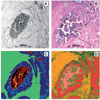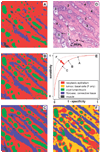Artificial neural networks as supervised techniques for FT-IR microspectroscopic imaging
- PMID: 19960119
- PMCID: PMC2786225
- DOI: 10.1002/cem.993
Artificial neural networks as supervised techniques for FT-IR microspectroscopic imaging
Abstract
In this report the applicability of an improved method of image segmentation of infrared microspectroscopic data from histological specimens is demonstrated. Fourier transform infrared (FT-IR) microspectroscopy was used to record hyperspectral data sets from human colorectal adenocarcinomas and to build up a database of spatially resolved tissue spectra. This database of colon microspectra comprised 4120 high-quality FT-IR point spectra from 28 patient samples and 12 different histological structures. The spectral information contained in the database was employed to teach and validate multilayer perceptron artificial neural network (MLP-ANN) models. These classification models were then employed for database analysis and utilised to produce false colour images from complete tissue maps of FT-IR microspectra. An important aspect of this study was also to demonstrate how the diagnostic sensitivity and specificity can be specifically optimised. An example is given which shows that changes of the number of teaching patterns per class can be used to modify these two interrelated test parameters. The definition of ANN topology turned out to be crucial to achieve a high degree of correspondence between the gold standard of histopathology and IR spectroscopy. Particularly, a hierarchical scheme of ANN classification proved to be superior for the reliable classification of tissue spectra. It was found that unsupervised methods of clustering, specifically agglomerative hierarchical clustering (AHC), were helpful in the initial phases of model generation. Optimal classification results could be achieved if the class definitions for the ANNs were carried out by considering the classification information provided by cluster analysis.
Figures





References
-
- Kidder LH, Kalasinsky VF, Luke JL, Levin IW, Lewis EN. Visualization of Silicone Gel in Human Breast Tissue using new Infrared Imaging Spectroscopy. Nat. Med. 1997;3:235–237. - PubMed
-
- Lasch P, Naumann D. FT-IR microspectroscopic imaging of human carcinoma thin sections based on pattern recognition techniques. Cell. Mol. Biol. 1998;44(1):189–202. - PubMed
-
- Chiriboga L, Xie P, Yee H, Zarou D, Zakim W, Diem M. Cell. Mol. Biol. 1998;44(1):219. - PubMed
-
- Lasch P, Haensch W, Kidder L, Lewis EN, Naumann D. Colorectal adenocarcinoma characterization by spatially resolved FT-IR microspectroscopy. Appl. Spectrosc. 2002;56(1):1–9.
Grants and funding
LinkOut - more resources
Full Text Sources
Other Literature Sources
